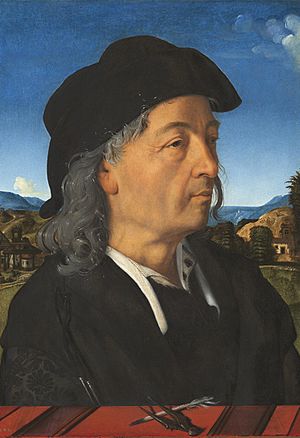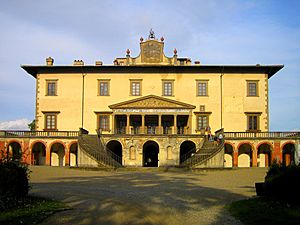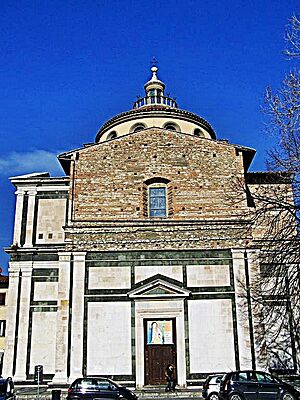Giuliano da Sangallo facts for kids

Giuliano da Sangallo (born around 1445 – died in 1516) was a talented Italian sculptor, architect, and military engineer. He lived during the exciting time of the Italian Renaissance, a period of great art and new ideas. Giuliano was especially known as the favorite architect of Lorenzo de' Medici, a very powerful and rich leader who supported many artists.
For Lorenzo, Giuliano designed a beautiful country house (villa), a monastery for Augustinians (a type of monk), and a church built where people believed a miracle happened. He also built many important buildings for Pope Julius II and Pope Leo X, who were powerful leaders of the Catholic Church. Giuliano was inspired by famous architects like Leon Battista Alberti and Filippo Brunelleschi. In turn, he influenced other great Renaissance artists such as Raphael, Leonardo da Vinci, his brother Antonio da Sangallo the Elder, and his sons, Antonio da Sangallo the Younger and Francesco da Sangallo.
Contents
Giuliano's Early Life
Giuliano da Sangallo, whose real name was Giuliano Giamberti, was born around 1445 in Florence, Italy. His father, Francesco Giamberti, was a skilled woodworker and architect. He worked closely with Cosimo de' Medici, Lorenzo's grandfather. This connection helped Giuliano and his brother, Antonio, later in life. It allowed them to become close friends and colleagues with Lorenzo de' Medici.
As a child, Giuliano became an apprentice to a joiner (someone who builds things with wood). His amazing skills in woodworking, building, and sculpting caught the eye of Lorenzo de' Medici. Besides his apprenticeship, Giuliano studied the works of ancient Roman architects. He also learned from more recent masters like Leon Battista Alberti and Filippo Brunelleschi. This helped him develop his creative vision and learn about classical design. It also started a lifelong working relationship with Lorenzo de' Medici.
Giuliano's first big independent job came from the Medici family. It showed his skill in architecture and his knowledge of building defenses. Lorenzo de' Medici asked Giuliano to build military forts and manage weapons in the town of Castellina. This was to defend against an attack led by the Duke of Calabria. Giuliano successfully pushed back the enemy forces. This proved his natural talent for military building and strategy.
Major Projects
Medici Villa at Poggio a Caiano
Giuliano's victory in Calabria made Lorenzo de' Medici trust him even more. So, Lorenzo asked Giuliano to design a country house, or villa, in Poggio a Caiano. Lorenzo even held a competition to find the best design, and Giuliano won.
Construction on the villa started in 1485. It was mostly unfinished during Lorenzo's lifetime. His son, Giovanni, made sure it was completed after he became Pope Leo X. Giuliano's design included classic elements like Ionic columns and a front that looked like an ancient temple. The Medici Villa in Poggio a Caiano is one of the oldest examples of a Renaissance-style country villa. It inspired many architects who came after Giuliano.
Santa Maria delle Carceri
In 1484, a child in the town of Prato said they saw a painting of the Virgin Mary and baby Jesus come to life. This happened on the side of the public jail. The townspeople declared it a miracle. They decided a church should be built at that spot to remember the vision.
For this project, Lorenzo de' Medici again hired Giuliano, his favorite architect. Giuliano's designs were heavily influenced by his studies of Alberti and Brunelleschi. He used a "Greek cross plan." This is a classical layout where four parts of the church are all the same length, extending from a central area. This design had not been used much in the Renaissance before this church. Construction began in 1486, but the front of the church is still unfinished today.
Reggia in Naples
In 1488, after the first plans for the villa in Poggio a Caiano were made, Lorenzo de' Medici asked Giuliano to build a castle for Ferrante of Aragon, the King of Naples. Building this castle was part of a bigger political plan. Leaders of different Italian city-states would send gifts, painters, sculptors, and architects to each other. This was a way to show friendship and good relations.
By sending Giuliano to Naples, the Medici family also wanted to spread Florentine culture and architecture across Italy. Giuliano planned to build the castle near the open land by Castel Nuovo. Sadly, the castle was never built, but his drawings of the plan still exist. The palace design had elements similar to Giuliano's first big job, the Medici Villa. Both designs featured a raised platform, two stairways leading to the main entrance, and a porch between the stairways. Also, both buildings were designed to be rectangular and perfectly balanced.
After Giuliano finished his work for the king, he was sent back to Florence with gifts. These included money, paintings, and sculptures. Giuliano gave many of these gifts to Lorenzo de' Medici to show his thanks for Lorenzo's support.
While Sangallo was designing the palace for the King of Naples, the King's son, the Duke of Calabria, wrote to Lorenzo de' Medici asking for a palace design too. Lorenzo sent another architect named Giuliano da Maiano to design the Duke's palace, called Poggio Reale.
Church of San Gallo
After Giuliano returned from Naples, Lorenzo once again asked him to build a church. This church was for a group of Augustinian monks. This project was meant to show how the Medici family supported public works in Florence. Based on letters from that time, historians believe construction began in 1488.
The Chiesa di San Gallo was named after Saint Gall of Ireland, a saint from the seventh century. According to Giorgio Vasari, a famous Renaissance writer, Lorenzo loved the design so much that he started calling Giuliano "Giuliano da San Gallo." This name stuck, and Giuliano jokingly told Lorenzo that his real family name, Giamberti, would be forgotten. Lorenzo replied that Giuliano deserved to start a new family line with the name Sangallo. Also, the city gate closest to the church became known as Porta San Gallo.
During the Siege of Florence in 1529, the Florentine army retreated inside the city walls. Unfortunately, since the church was built outside the city walls, it was destroyed.
Palazzo Gondi
Around the same time Giuliano da Sangallo was building the Church of San Gallo, he also got a job from Giuliano Gondi. Gondi was a rich Florentine merchant from the old, powerful Gondi family of bankers. After hearing about Sangallo's work for the Medici family and the King of Naples, Gondi asked him to build a new Palazzo Gondi in Florence.
For this project, Giuliano used ideas from other large palaces in the city. These included the Palazzo Medici Riccardi and Palazzo Strozzi. Like those palaces, the Palazzo Gondi used finer types of stone on each higher level of its front. Sadly, like many of his projects, this palace was not finished during Giuliano's lifetime or during the lifetime of his patron, Giuliano Gondi. The palace continued to be worked on and expanded for almost two more centuries. Because of these changes, historians have not been able to figure out Sangallo's exact original plan.
Palazzo della Rovere
Soon after Giuliano finished his work on Santa Maria delle Carceri, his patron and longtime friend Lorenzo de' Medici died in 1492. After Lorenzo's death, there was a struggle for power. This allowed France to invade Florence in 1494. The French invasion forced the Medici family and their supporters, including Giuliano, to leave Florence and go into exile.
Two years earlier, the Bishop of Ostia, Giuliano della Rovere, had also left Italy. This was after his rival, Rodrigo Borgia, was elected Pope as Alexander VI in 1492. Sharing the experience of exile, and knowing Giuliano's past work as an architect, Della Rovere convinced Sangallo to design a palace for him in Savona, France.
The palace design was greatly influenced by the Bishop's other properties. These included his estate in Vincoli and the fortress in Ostia that Sangallo had helped renovate. Giuliano della Rovere wanted his palace in Savona to be the biggest in the city. He was competing with his cousin, Rafaelle della Rovere. Della Rovere achieved this by buying the properties around his family's estate. Like Alberti's design for the Palazzo Rucellai in Florence, Sangallo made the palace look like one large, impressive building even though it was made up of several smaller ones. Also like the Palazzo Rucellai, Sangallo made each higher level of the front appear smaller. This made the building look even more grand from the street.
Later Career and Death
Giuliano's final work was helping to design and build the new St. Peter's Basilica in Rome. Sangallo was asked to design the new church. However, Pope Julius II chose Donato Bramante instead, and construction began in 1506. Giuliano was called by Julius II to help Michelangelo remove mold from the Sistine Chapel ceiling. Michelangelo had used plaster that was too wet.
After Giuliano's impressive career and close work with Julius II, Bramante's promotion left Giuliano very upset. He left Rome and went back to Florence. After Julius II died, Giovanni de' Medici was elected Pope Leo X in 1513. When Bramante also died in 1514, Giuliano was called back to Rome from Florence to help rebuild the basilica. However, by this time, Giuliano was over 70 years old and not well enough to travel to Rome and manage such a huge project. So, Pope Leo X chose another famous artist, Raphael, to take over the design of the new basilica.
Giuliano died in Florence in 1516.
Legacy
Giuliano's legacy is different from other architects of his time. Many of his biggest works were never finished or are no longer standing. Examples include Santa Maria delle Carceri, Palazzo Gondi, and the Church of San Gallo. Instead, his legacy is mostly based on his ideas and influence.
Sangallo's legacy lives on through his Sienese Sketchbook. This sketchbook gives a close look into Sangallo's mind. It includes his ideas for many things, from new types of weapons to church domes and sculptures. Many of these designs came with measurements and technical details. The sketchbook also has drawings Sangallo made of existing buildings he saw during his travels across Italy and Europe. This shows that Sangallo was interested in studying both medieval and classical architecture.
Besides the sketchbook, the name Sangallo became linked with high-quality architecture because of Giuliano's amazing career. As his reputation grew, other architects of the time started using "Sangallo" as part of their names. They wanted to connect themselves with Giuliano's skill and talent.
See also
In Spanish: Giuliano da Sangallo para niños





